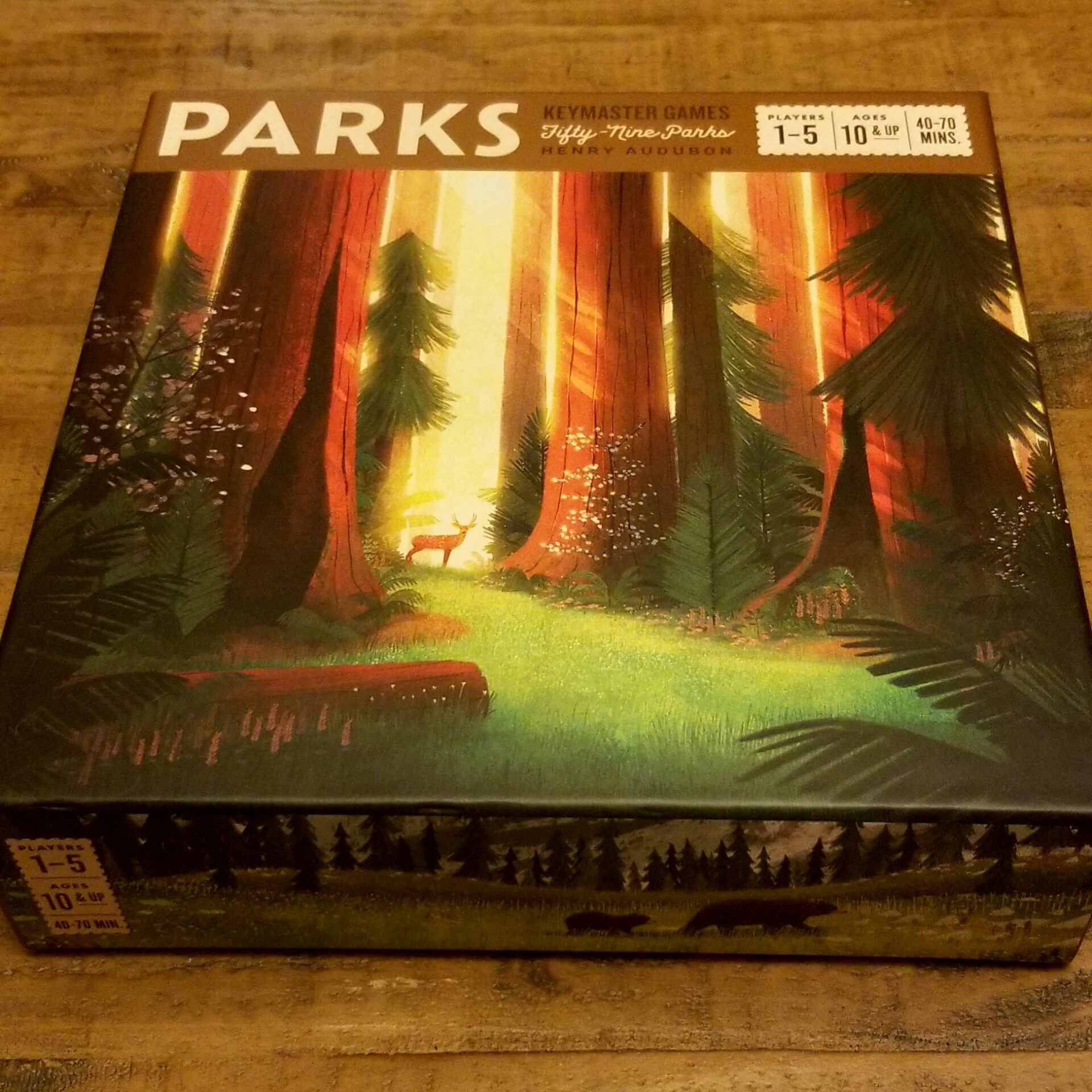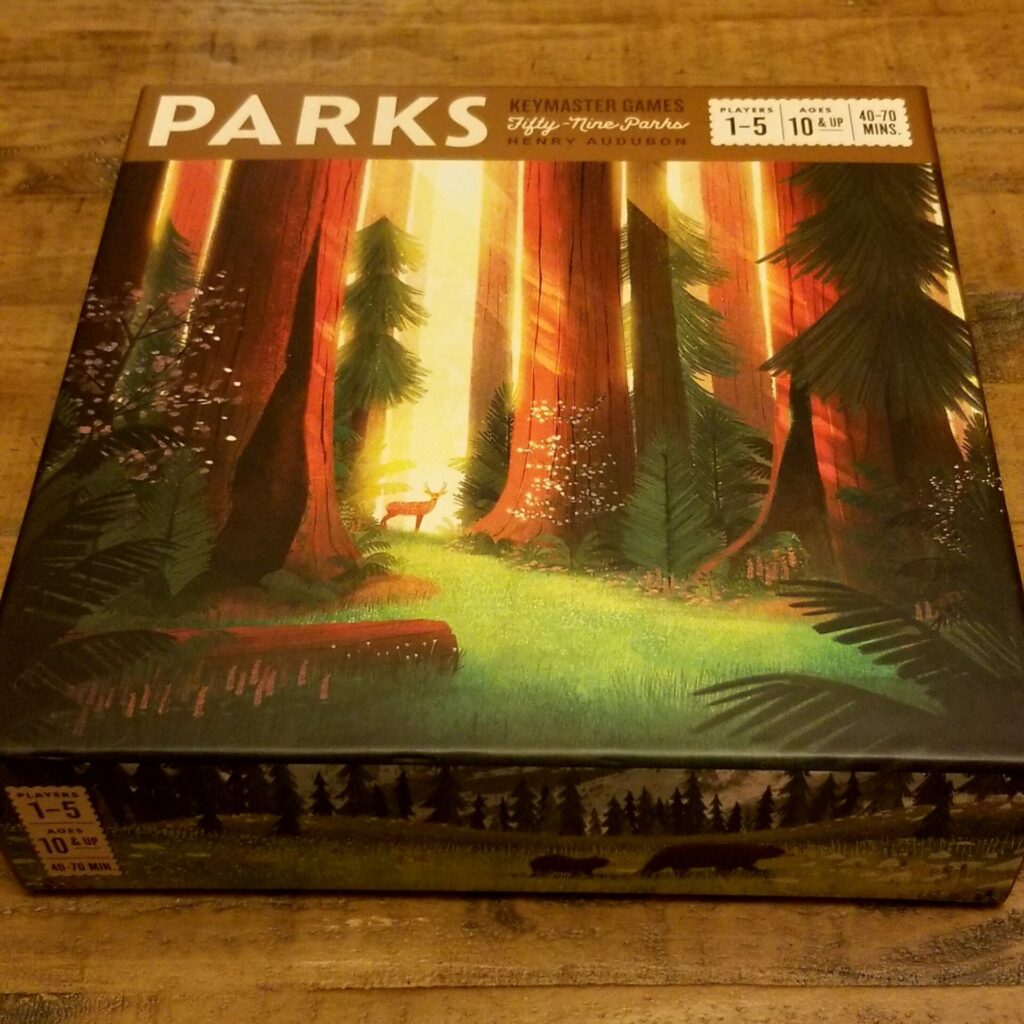
Name: PARKS
Year of Release: 2019
Player Count: 1 – 5 Players
Playing Time: 30 – 60 minutes
Designer: Henry Audubon
Publisher: Keymaster Games
Primary Mechanisms: Set Collection, Track Movement
Weight (According to boardgamegeek.com): 2.15
Overview
You know those games that you have on your list, and you find yourself looking at a lot, but you just don’t make the “purchase” leap after all the researching? Maybe you read an un-flattering review. Maybe the price point is a little high for your liking? Maybe nobody in your gaming group is interested? PARKS has been one of these titles for me. Whenever I saw an article on the game, or saw it in person, I’d marvel over the artwork and think about how I really wanted the game. But then I’d just move on with life without thinking of it, until our next chance meeting.
I happened upon the game again during the first of the year. My family and I were trying to kill time between leaving one relative’s house in Chattanooga, TN and making the trek to Cartersville, GA to see another relative. We stopped by a Barnes & Noble as there is always something for all three kids to look at and my wife wanted a coffee. As usual, I wandered over and spent some time at the LEGO area as well as the Board Game shelves. And sitting there, the last copy of its kind, was PARKS. I talked my wife into us purchasing it because we didn’t bring any board games on this trip, and we’d be at my mom’s for two nights with nothing to do. So, to the counter I walked with my new treasure in hand, ready to see if it lived up to my expectations. That said, let’s get into the review of the board game PARKS.
Rules and Setup
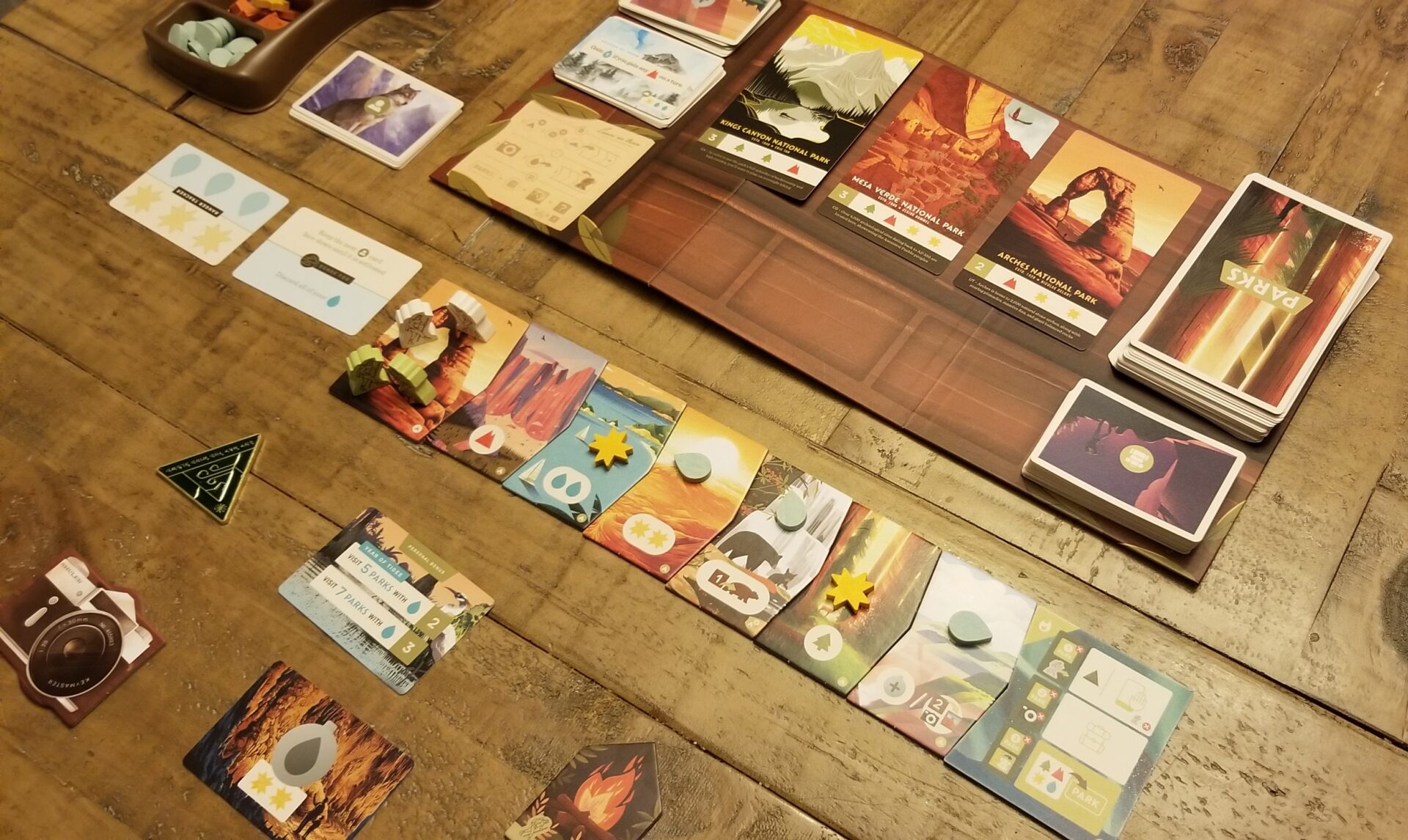
The setup to PARKS in both multiplayer and solo variants is quick, probably around 5 minutes. It’s a small thing but I enjoy games where the solo setup isn’t much different from the multiplayer as it’s just easier to remember, plus I can change from multi to solo quickly as it is very common in my household for my wife to say she wants to play a game and then by the time set up is done, she has decided that she just wants to watch television.
PARKS comes with superb components to match its excellent artwork. There is a stack of trail tiles (including a trail head and a trail end) that will make up the trail each game. These are thick cardboard cutouts with gorgeous artwork and some simple symbols for direction. There are 5 starter tiles that are static and will make up the trail during every season and every game you play. In addition, there are 4 advanced tiles (a 5th one is used if you are playing with 4 or 5 players) where 1 tile is shuffled into the trail each season, lengthening the trail you are traversing.
Along with the tiles, there are numerous decks of small cards. The cards include decks for canteens, weather elements, gear, year-end goals, and a deck to use for the solo variant. I’ll get a little into how these decks work in the gameplay section below. The small decks aren’t the only cards you get though. The parks you will be visiting are represented by beautifully rendered artwork on tarot-sized cards. This is the first game I own that uses this sized card and I’m in love. The cards detail 48 different national parks in varying styles to capture the differing locales. The breadth of artists is pretty astonishing so you can marvel over a new vista every time a new park card is flipped. These cards alone almost make the game worth the price of admission. Each card has a selection of resources on it which is used as the “price” to visit the park, meaning during gameplay you take the card into your collection and will be the main driver of points at game end.
Rounding out the components are wonderful wooden tokens used for resources, small cardboard pieces used for photos, some wooden hikers (or rangers as some of them become in the solo variant) and a hefty, metal triangle used for the first player marker. I have no clue why this marker is metal when at most, it is just passed back and forth between seasons. I would have liked to see such a nice component used for more than just a first player marker. I also want to call out the wooden animal tokens that act as wild resources. The designers could have easily just made a bunch of wooden bear tokens but instead they included around 12 unique animal shapes to use in play.
To set up, you shuffle the different decks, sometimes placing them on the tri-fold board, sometimes dealing yourself one card and putting the rest in the box. You set up the trail as I mentioned above, put your two hikers and two rangers on the trail head, and lay out the weather tokens (either suns or rain drops) on the trail tiles depending on the weather element card drawn. Boom, you’re ready to go on a hike right in your dining room and you don’t even have to mess with the bug spray.
Gameplay
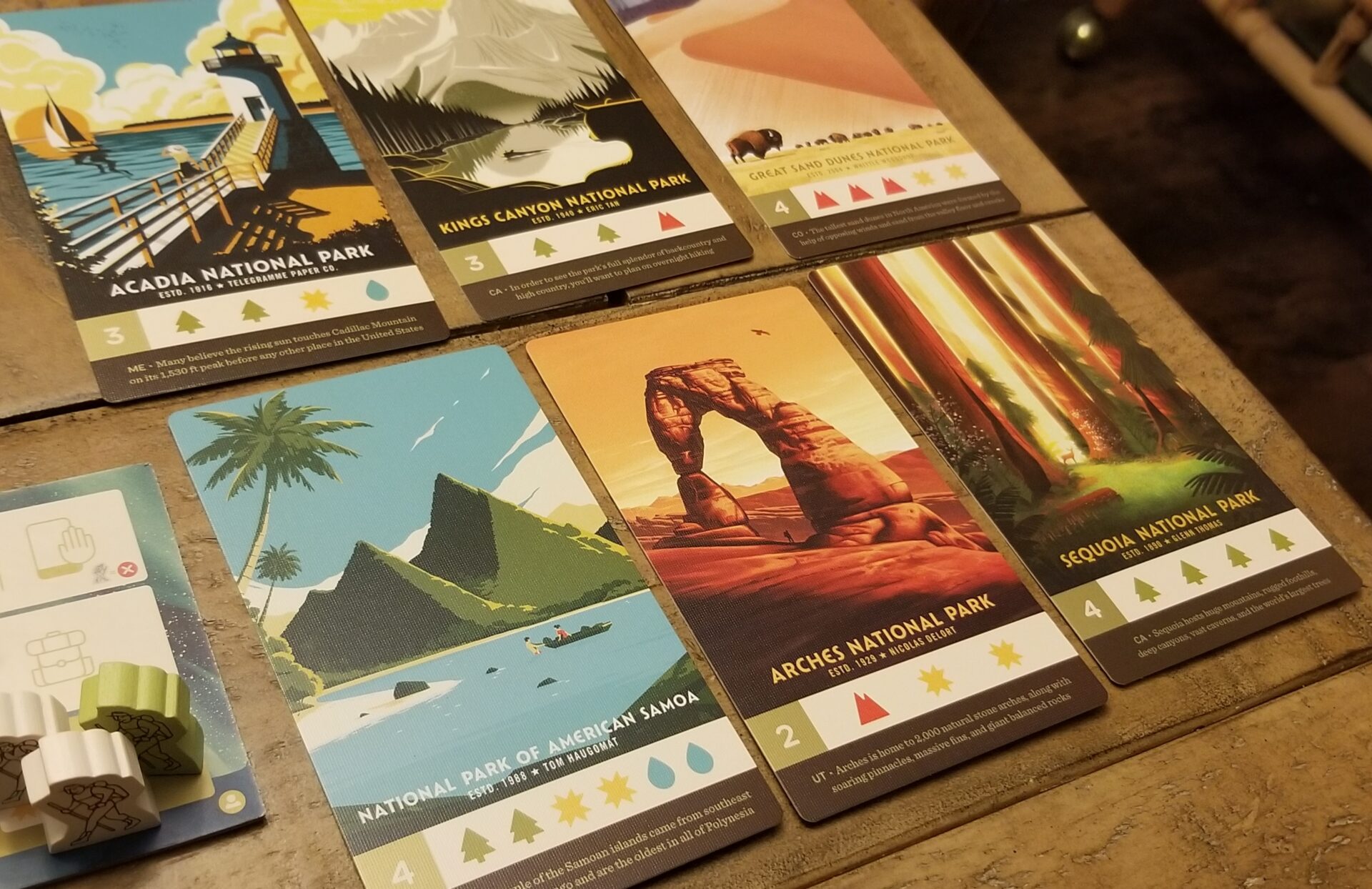
I’ve mentioned the artwork a few times in this write-up and if you’ve ever read about this game before, those write-ups have undoubtedly mentioned the artwork too. So, enough of the damn artwork! Let’s discuss the gameplay (or lack thereof?) Ok, that last sentence probably isn’t fair as I do enjoy this game but as my wife put it after a few plays, “Doesn’t it feel like it’s missing that one extra thing to put it over the top?” I would have to agree with her on this. Note: there is an expansion (Nightfall) that I have not played yet. This expansion might add that little extra umph to this game, but I can’t comment on it here.
In the solo mode variant, you move one of two hikers down the trail at a time, collecting the resources on the tile or fulfilling the action on the tile. Between turns, you flip over a gear card from the pile and depending on how much the gear cost (1 – 3 suns) you move one of the opposing hikers (called rangers in solo game) the necessary spaces. The manual details how you know which ranger to move in relation to your hikers on the trail. You do this, back and forth, until both your hikers have reached the end of the trail, or until both the rangers reach the trail end. Sounds simple, and it is, but there are a few catches to make it interesting.
First, two hikers can’t populate the same space usually. At the start of the game, you are given a campfire token that is lit on one side and has a smoldering fire on the other. If you select to share a space between two hikers, you must flip your campfire over to put it out. You now cannot choose to share a space again until you re-light your campfire. This is done by getting one of your hikers to the trail end. This catch is really where most of the decision making comes in because resources are very scarce on the trail. For example, there is typically only one space to collect a mountain resource. You might find yourself needing to “visit” park cards where you need multiple mountain resources to collect this card. In this case, that space becomes very important as do some of the other tiles that allow to trade in one of any resource for another resource token.
Second, the trail end tile has three choices for season ending actions. One of these is the action to visit a park which is where most of your points are going to come from. The solo variant handles these season ending actions by allowing the rangers to take the action that corresponds to the gear cost that was drawn when they reached the trail end. For example, a ranger is two tiles away from the trail end and you draw a gear card that costs 3 suns. You move the opposing ranger it’s three steps, and because she has reached the trail end, she takes the third action which is to get rid of the right most park card and then shuffle gear cards back into the deck. Each action allows the ranger to discard one park (that won’t be replaced until the next season) as well as some other small action. This whole thing really adds to the “race” aspect of the game, more so than my experience in 2 player games. In solo, I find myself attempting to collect resources because I’m gunning for 1 or 2 certain parks but there is always the chance that a ranger reaches the trail end first and discards the card I wanted. Now I collected these specific resources for nothing!
The last catch in the solo variant are the solo event cards. Event cards are actions that are triggered by the rangers when they collect a total of 3 suns or 3 rain drops. The rangers collect these by being the first to reach the tiles impacted by the weather cards at the beginning of each season. Truthfully, some of the event cards can be detrimental. In the playthrough leading up to writing this, I had two different events happen (both having to do with discarding all of a certain resource from my hand) that had a severe impact on reaching my goals.
Once hikers/rangers have reached the trail end, the trail is randomly laid out (with another of the advanced tiles added to the stack), a new weather card is displayed, and the sun and rain drop resources are put out. Empty park slots are replaced, hikers are moved back to the trail head and the game is ready for another season. 4 of these seasons and the game is done and your trek is complete.
Conclusion
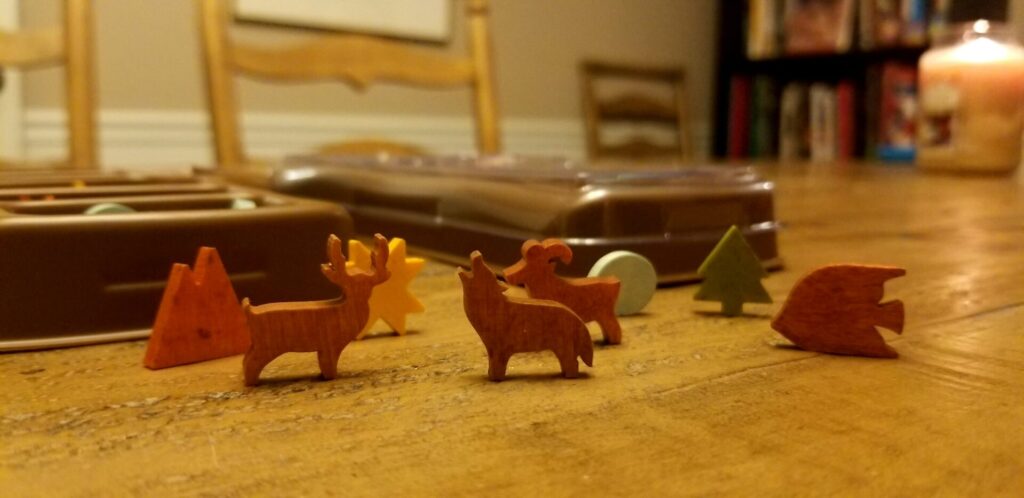
As mentioned above, this game is a fun little filler and I really do appreciate how the solo variant plays out, but there are just a few too many things that just don’t feel 100% complete to me.
- The year-end goals are basically worthless. You are given two at the beginning of the game and choose one to keep. This is similar to the cards in Wingspan except at least those feel meaningful. At most, the PARK cards give you an extra 3 points and that is typically only rewarded after a lot of work. You might as well just visit a 3-point park and not even worry about the year-end reward. I have never found it worth planning a strategy around in order to meet this goal.
- Along with the year-end goals, the gear cards really aren’t enticing enough to spend an action on them. While they are used in solo mode to move the rangers, you can also actually purchase them to enhance your abilities throughout the game. Why didn’t I mention this above? Because I don’t ever do it unless I’m forced into it. And why don’t I do it? Because to buy gear, you’d either have to select that as your end of season turn (instead of visiting a park) or use the one advanced tile that allows you to buy gear THAT ALSO allows you to visit a park. I’ve never wanted to buy gear instead of visiting a park unless all the park cards were discarded or, if for some reason, I only had suns as resources and nothing else. I wish there was a different way of collecting gear as some of the cards give interesting powers and it could definitely change your playstyle from game to game.
If the two decks above were re-tooled for a more meaningful experience, I think that this game would be an excellent addition to anyone’s library. But as it stands right now, it seems more like a gateway game which is fine but might not be for everyone.
If you’re looking for an engrossing brain burner, this isn’t for you with its 2.15 weight rating on boardgamegeek.com, but it might scratch your itch if you’re in the market for a relaxing 30 minute game that is good for both solo and 2 player modes (and possibly more but I haven’t played with more than 2.)
Rating
Ratings are based on 5 main criteria: rulebook, setup, components, art & graphic design, and gameplay. The first 4 criteria are rated 1 to 5 and the gameplay is rated 1 to 10. These scores culminate in an “overall satisfaction” score that is rated from 1 to 10. If the reviewed game has both a solo and multiplayer mode, I have assigned scores separately to give context to which mode we enjoy more.
Links
As an Amazon Associate I earn from qualifying purchases.
Amazon: PARKS Board Game
Amazon: NIGHTFALL Expansion
Also, if you are interested in playing the PARKS expansion NIGHTFALL, check out our YouTube review of the expansion:

